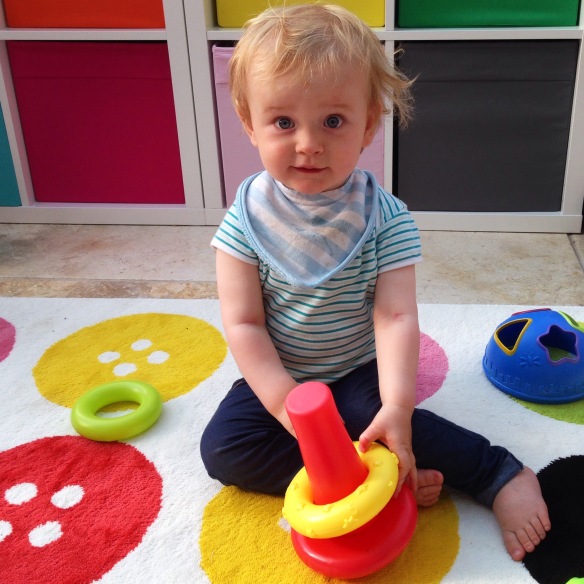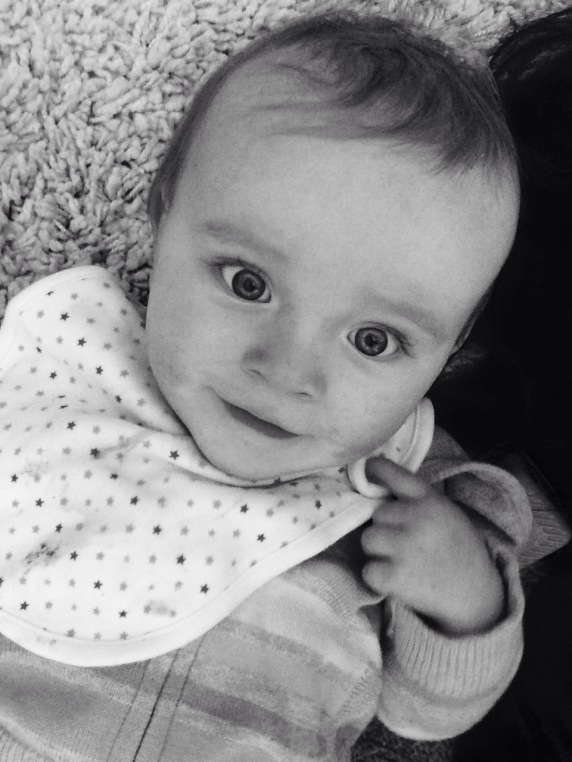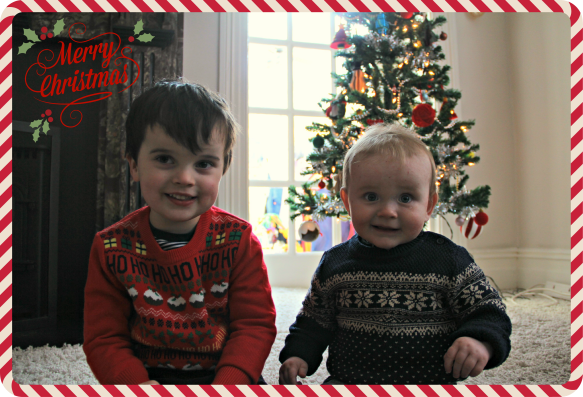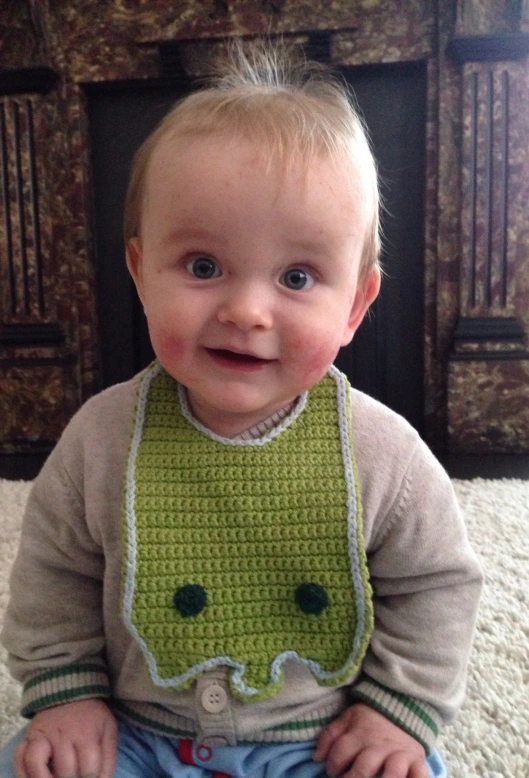Again, a caveat: I am Not That Kind of Doctor, so what follows
is merely a record of my personal experience with infant feeding.
Please don’t take what I write as a substitute for medical advice!
This post may also include words such as engorgement, lactation
and other breast-related things. You have been warned.
It has taken me a long time to start writing this post, which is due in part to the fact that I still feel rather conflicted about the issues involved. From a medical point of view, I feel somewhat ill-qualified to give an accurate perspective of the breast vs bottle debate, as I simply do not have the time, training or access to data which one would need to conduct a proper scientific survey of the medial and nutritional issues involved. Additionally, I realise that the fraught question of how and what parents feed their babies is inextricably bound up with a variety of societal factors, including class, education, the availability of a support network, body image, bonding, and mental and physical health. These can both increase pressure upon the feeding parent, and act as a confounding factor, making it harder to determine with certainty whether the apparent advantages of breastfeeding are causally related to the breastmilk itself, or merely correlated. Nonetheless, this is something I need to get off my chest (Gah! The pun: it hurts!), and I hope that reading about my experiences might help someone else in the future.
Many first-time mothers have doubts about their ability to breastfeed adequately, typically centred around the concern that the baby might not be getting enough nourishment. Some of those fears may be justified, some are probably not. I, however, knew from the first that I was likely to face problems with breastfeeding and milk supply, as, in 2004, I had had a breast reduction. If you are interested in the details (and you might well be: the type of reduction surgery performed can impact differently on your future ability to breastfeed), I had a Lejour reduction, and I remember the surgeon telling me he had removed at least 2lb of tissue from each breast, which would mean I lost somewhere between 1.5 and 2kg of breast tissue in total. The surgery was performed for free by the NHS as I was suffering from bad back and shoulder pain, thanks to my over-generous frontage. I was still left with large breasts: it took a while for things to settle down after the operation, but eventually I ended up being about a 32E. Considering I had started off as a 30G, though, I could deal with not being a petite B-cup: I may still have been curvy, but things were much more balanced, and I wasn’t in pain any more. My overriding emotion was gratitude: suddenly I could do all sorts of things in ease and comfort: play sports, run for the bus, wear dresses, find underwear in a colour that wasn’t surgical beige… For a while, everything was peachy. Then, in 2011, I had Eoin, and things went a bit wrong.
My first pregnancy: I fail at breastfeeding
If you have read the other posts in this series, you’ll know that I had gestational diabetes during both pregnancies, and that it really knocked me for six the first time. As a nervous first-time mum with an inconvenient history of anxiety, I was very concerned about the impact my feeding choices might have on Eoin, and I was firmly convinced that one of the ways I could attempt to right some of the wrongs I had done him by being diabetic (I know, I know) was to do everything I could to ensure I fed him breastmilk instead of formula. In some cases, mothers are able to feed very successfully after reduction surgery, and I was determined I was going to be one of them. I haunted the BFAR website, I grilled my midwife, I had several pre-natal appointments with lactation consultants. I was delighted when I realised that I was able to produce some colostrum, and, on the advice of the hospital, diligently set about harvesting it. Unfortunately, colostrum-harvesting is a time-consuming, tricky business, and it is certainly not helped by being so terrified about your blood sugar levels that you are essentially starving yourself. For weeks during my third trimester, I sat on my sofa with a bag of sterile syringes, getting hungrier and sadder, expressing until I was covered in bruises, yet producing only one or two millilitres of precious liquid a day. By the time I went into labour with Eoin, I had collected about 30ml: to put this in context, this is roughly the amount that a newborn might be expected to drink in about two feeds in the very early days. I fed this to him from a cup while in hospital, and put him to the breast whenever he was hungry. My technique was assessed by a range of midwives, nurses and lactation consultants, who all agreed everything was going excellently. I was patted on the back and sent home on day three after the birth, certain that I wasn’t going to need those bottles and the box of formula I had bought “just in case”. It was at this point that the problems started.
Even in breasts which have not been tampered with, it takes a few days for the milk to come in after birth, and, unfortunately Eoin was desperate for more food before my body was in any way ready to give it to him. He was latched on pretty much constantly for the third day and night, but the only thing that happened was that he got progressively more ravenous. It was only at three in the morning, when he was utterly hysterical with hunger, and had lost his voice from screaming, that I recognised I was going to have to give him formula. I fumblingly mixed up a bottle, fed it to him, and was horrified when he just kept screaming. I remember thinking that all I had done was give him the energy to be really furious. It took another bottle half an hour or so later before he finally calmed down and fell asleep; when I woke up a couple of hours later and heard no crying, I was half-convinced that he was dead, so constant had his distress been until that point.
Notwithstanding the two emergency bottles, I was still certain that I could try to feed Eoin myself, and, the next morning, set about latching him on when he woke up. Unfortunately, and unbeknownst to me at the time, I was beginning to feel the first stirrings of post-natal depression. This initially manifested in a rather odd way, although I have since met one other person with identical symptoms: I would be physically sick for much of the time, notably whenever I held Eoin. This got worse very quickly, until I could only hold him for a few seconds without vomiting. The doctor gave me anti-emetics, but I wasn’t able to keep them down. I was then given omeprazole, which, while it stopped the actual sickness, did nothing alleviate the rushes of nausea I would suffer whenever I held Eoin, or whenever he cried. It was only when the PND was diagnosed, and I was able to start taking citalopram, that things got even a little better. In the immediate aftermath of the birth, though, I was really rather unwell: I couldn’t eat, I lost weight dramatically quickly, I was permanently cold and exhausted, and I was pretty much unable to hold my son. Against this backdrop of mental and physical sickness, I was simply unable to continue trying to feed Eoin myself. I did try, but still no milk came in, and still he screamed hysterically until I caved and offered him the bottle. It was only a couple of days after having decided that formula feeding was the only viable choice for us that I finally showed signs of engorgement. I remember thinking how horribly mistimed it was, but in truth it is highly unlikely that I could have continued trying to breastfeed given how ill I was. The whole thing felt like a horrid failure from beginning to end: as I saw it, I hadn’t managed to carry Eoin successfully, I couldn’t give birth to him myself, I couldn’t feed him. The pleasure I should have been able to take in my new baby was entirely sucked away, leaving at worst a depression and at best a flat hopelessness that lasted for around a year and a half.
My second pregnancy: I fail at breastfeeding again, but I fail better
With Ronan, my feeding goals were much more modest: I knew that exclusive breastfeeding would be unlikely to happen, but I decided that I was still going to try to breastfeed him if possible, even if this might ultimately be doomed to failure. The stretch goal, so to speak, would be successful mixed feeding, but, again, I was under no illusions that this might not be possible. I was pleasantly surprised, when discussing my feeding plans with midwives during my antenatal appointments, that nobody turned a hair: I was assured that I would get all the support they could give if I wanted to try to persist with breastfeeding, but that nobody would judge me in the slightest if I ended up using formula. Crucially, I was reassured with the words I had never heard during my first pregnancy, namely that formula is absolutely fine for the baby, and, while breastfeeding is obviously a wonderful thing, it is only best if it works for both the mother and the child. I still prepared myself for both types of feeding, unpacking both the breast pump and the bottles, and stashing an emergency box of formula in the kitchen cupboard. I still expressed and stored colostrum, but, crucially, I didn’t feel anxious and beleaguered about it in the way I had done the first time around. In fact, when I arrived at the hospital for my section, clutching a cool bag full of syringes of frozen milk, the midwife on duty was somewhat taken aback, and told me that they didn’t normally see people being so prepared.
Feeding got off to a slightly rocky start: due, perhaps, to the insulin I had needed to take before the delivery, Ronan’s blood sugar levels were very low after birth, and the milk I could give him was not doing enough to bring them back to an acceptable level. For the first two days he was given small formula top-ups on the consultant’s advice, via a nasogastric tube. As you might imagine, he was not best pleased with the tube (he pulled it out himself after 24 hours), but his sugars soon stabilised, and, when we were released from hospital, he was happy, healthy and taking a mixture of breastmilk and formula. Midwives and the health visitor called regularly at the house over the next few days, and I was, proudly, able to show them that I was indeed managing to breastfeed Ronan, at least for some of the time. Latches, positioning and the like were checked, and everything seemed to be going well. I noticed, however, that, no matter how long I tried to feed him for, he never seemed settled. Indeed, he seemed to get more and more dissatisfied as time went on, fussing and pulling away after a couple of minutes, and he only really seemed to calm down after he subsequently had formula. I decided to break out the heavy-duty breast-pump, and see what I could managed to extract from myself by main force and industrial-strength suction. The answer, sadly, was not much. No matter how relaxed I was, no matter how much I thought of Ronan, the most I could ever pump was the foremilk: no let-down ever happened. One particularly prolific day, after spending hours hooked up to the infernal machine, I managed to collect about 80ml. On one hand, I was very proud of this, as I knew it meant that I knew for sure that I was producing something, and that he was getting some form of nourishment from me. On the other hand, when Ronan knocked this back without flinching in a single feed and then looked for more, it was apparent that I was never going to be able to give him more than a tiny proportion of the milk he required myself. Although I did consider persevering with mixed feeding, it soon became apparent that the game wasn’t worth the candle. At fourteen days old, Ronan had his last feed from me, and has been formula-fed ever since.
While I had an immense sense of guilt and failure over my formula feeding of Eoin, my emotions with Ronan were very different. A lot of this was probably due to the fact that I was not horribly depressed the second time, but I think it was also related to the fact that, with Ronan, formula feeding was a decision I was able to make in my own time, with the opportunity to weigh both the pros and cons without the sense of panic, terror and outright illness which assailed me previously. It was also a relief to realise what exactly was going on with my post-operation breasts: although I have no official diagnosis for this, it seems apparent that I have nerve damage following the reduction surgery, a not-unexpected consequence. With Eoin, I couldn’t understand why, when I was apparently able to produce at least some milk, he seemed unable to drink any useful amount. My discovery, with Ronan, of my missing let-down reflex explained a great deal: effectively my body was completely unaware that there was a baby trying to feed from it. While I could make milk, I couldn’t do anything useful with it. While this was frustrating on one hand, it was also immensely vindicating: on some level I had certainly blamed myself for not trying hard enough with Eoin. Maybe if I had pushed on and fed or expressed through the sickness, the dehydration and the fear, I could have managed to Do the Right Thing. But I hadn’t pushed on: I had just taken the easiest option… The self-hating internal refrain went on and on. It turned out, in fact, that there really was very little I could have done: try as you might, you can’t regrow your nerves through sheer force of will, and teaspoonfuls of foremilk on their own are not enough to be particularly useful to a baby. This time, I can honestly say that I felt very at peace with my decision not to pursue trying to breastfeed.
Why is it still difficult to write about formula feeding?
I began this post by saying I was still somewhat conflicted about the issues involved: I should note that this is not because I feel, in using formula, that I have in some way fed my children an inferior food. Obviously, breastmilk is the natural way for mothers to feed their babies: if it weren’t, we would be born with kettles and boxes of Cow and Gate strapped to our chests instead of mammary glands. However, while breastfeeding may be brilliant if it works for you and your baby, it is clear that formula is a perfectly good feeding choice too. The recent Ohio State University study into long-term outcomes from both feeding methods found that neither was appreciably more beneficial than the other. Crucially, this study examined feeding outcomes in relation to siblings, and so was able to eliminate a great deal of the selection bias seen in other studies of the long-term effects of breastmilk versus formula. For what it’s worth, I was myself formula fed as a child: barring the inexplicable gestational diabetes, I have no health problems, I am not obese, and I am bright enough to have managed to collect four degrees in various esoteric subjects. The fact that I was not breastfed does not seem to have done me any harm.
Why, then, do I still find it difficult on some level to be an “out-and-proud” user of formula? I said above that I was at peace with my inability to breastfeed, but note that, even though my chances of successful breastfeeding were very low, I still began by trying to feed Ronan myself. If I were to have another baby, I would do the same thing: mix-feed for as long as was practical, before moving on to exclusive formula feeding. I think the truth is that I now know what my physical and physiological limitations are, and this is comforting. As with so many things in pregnancy and parenthood, all one is trying to do is to regain a measure of control, of stability, of certainty. You want to feel you have done the Right Thing, however that might be defined. Bluntly, it seems to me that the breast-versus-bottle debate is concerned not so much with the nutritional, developmental and sociological benefits of one particular type of infant feeding versus another as it is with the way you define yourself as a mother, as a woman, as a thinking, responsible person. It shouldn’t be this way, but nonetheless your feeding choices invariably seem to brand you: modest/immodest, feckless/overattached, selfish/selfless, martyr, hero or villain. I confess that I feel the need to tick a box here: if I’ve given a baby my expressed colostrum, if I have tried to feed them myself, then I have done all I can, and I can continue to feed them formula with a clear conscience. But – and this is a big but – why do I feel I need this absolution in the first place? Why not feed formula from the first, if you know that, realistically, this is what you will be doing in a few days anyway?
Absolutely honestly, I think my reasoning stems, predictably, from guilt: my reduction, while medically very desirable, was not a life-saving procedure. I could have held on, surgically unaltered, and perhaps then I would have been able to feed my children myself. Perhaps, though, things would still have gone wrong, and I would then be beating myself up for another set of reasons. I don’t think I have managed to deal properly with this guilt yet, absurd as this might seem to other people. What I do know, though, is that for every irrational twinge of reduction/formula-based shame that I feel, another mother is feeling a very similar emotion for another reason. Extended breastfeeding, switching from breast to bottle, exclusive pumping, feeding through reflux, allergies and intolerances: all of these choices involve hard work and soul-searching, and all are likely to incur the judgement of outsiders. This, really, is the nub of the matter: as parents, we place enough pressure on ourselves without having to deal with the hoiked-up judgeypants of the neighbours, the people at playgroup, the staff of the fancy hotel restaurant (I’m looking at you, Claridges), and the Daily Mail. I have never felt so bad about formula feeding, or so angry at others’ thoughtlessness, as the day that someone came up to me in the cafe at Anglesey Abbey and told me that, if I had only loved him enough to breastfeed him, Eoin would have been happy and content instead of crying. This is the kind of nonsense no parent should have to deal with: life and infancy are far too short to agonise over whether a baby’s milk comes out of a breast or a packet. However you feed, you are doing your best. You will be fine. The baby will be fine. Unless there are medical issues at play, your feeding choices are yours to make, and none of anyone else’s business. The most important thoughts I could leave you with are the mantras of both the BFAR organisation and the Fearless Formula Feeder website. The former states that, in attempting to breastfeed after surgery, you must define your own success, whether that be through colostrum harvesting, the use of a pump or a supplemental nursing system, or simply through knowing that you have done all you can for your child. Measuring yourself against an unreasonable standard is not helpful. The Fearless Formula Feeder reminds us that the most important words we can say to any mother about her feeding choices are “I support you“.
This is how I would like to end: if you are reading this post because you are contemplating breastfeeding after a reduction or some other surgery, or simply if you are struggling with feeding in general, however you are feeding your baby, whether by breast, formula or both, you are doing the right thing. Be proud, and ignore the judgey comments: the people who make them are honestly not worth bothering about. I support you.
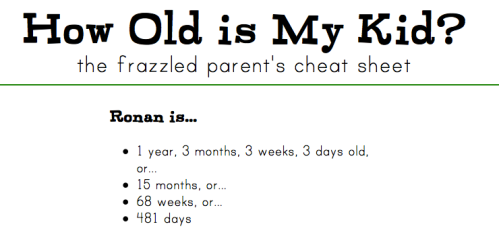 There you have it: 481 days old. No wonder I’m having trouble remembering: that’s an awful lot of broken nights’ sleep.
There you have it: 481 days old. No wonder I’m having trouble remembering: that’s an awful lot of broken nights’ sleep. He’s interested in food. Very interested. Extremely, passionately interested. If you are in the kitchen for any length of time, it won’t be long before you find him clinging to your leg, making rather pathetic noises. He has, you see, realised you are in The Place Where The Food Comes From: he hasn’t eaten anything for at least twenty minutes, and can any growing boy reasonably be expected to survive like that? I’m beginning to wonder if he is part-labrador, or the spiritual heir of Winnie the Pooh. He is, inexplicably, the only blonde in a brown-haired family, after all.
He’s interested in food. Very interested. Extremely, passionately interested. If you are in the kitchen for any length of time, it won’t be long before you find him clinging to your leg, making rather pathetic noises. He has, you see, realised you are in The Place Where The Food Comes From: he hasn’t eaten anything for at least twenty minutes, and can any growing boy reasonably be expected to survive like that? I’m beginning to wonder if he is part-labrador, or the spiritual heir of Winnie the Pooh. He is, inexplicably, the only blonde in a brown-haired family, after all.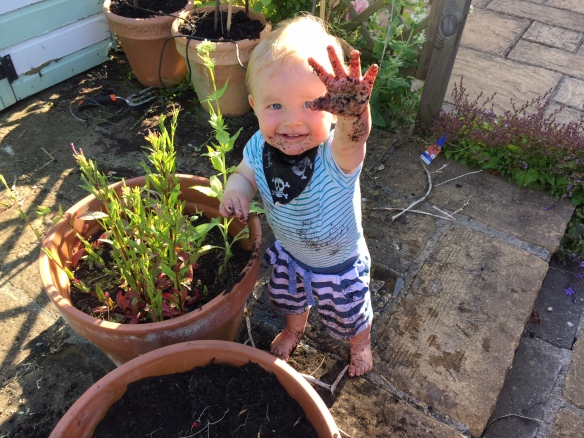 He loves fruit, cheese, the beach, taking all the pots out of the kitchen cupboards, his Geiriau Cant Cyntaf book, surreptitiously posting Harvey Margaret (his stinky toy rabbit) into the dustbin, chucking his bath toys into the shower with you when you are trying to wash your hair, “Sweet Child o’ Mine” (he’s moved on from “Piano Man”), and covering himself in earth while helping in the garden. He hates eating from his own plate when he could be eating from someone else’s, shampoo, or staying still for too long. His hair is never tidy, and I once found him trying to lick the toilet. He’s a lovely, crazy little ball of energy, and I wouldn’t be without him.
He loves fruit, cheese, the beach, taking all the pots out of the kitchen cupboards, his Geiriau Cant Cyntaf book, surreptitiously posting Harvey Margaret (his stinky toy rabbit) into the dustbin, chucking his bath toys into the shower with you when you are trying to wash your hair, “Sweet Child o’ Mine” (he’s moved on from “Piano Man”), and covering himself in earth while helping in the garden. He hates eating from his own plate when he could be eating from someone else’s, shampoo, or staying still for too long. His hair is never tidy, and I once found him trying to lick the toilet. He’s a lovely, crazy little ball of energy, and I wouldn’t be without him.
